ERP System for Supreme Dry Cleaners: Implementation Analysis
VerifiedAdded on 2023/06/05
|18
|4258
|259
Report
AI Summary
This report provides a detailed analysis of Enterprise Resource Planning (ERP) system implementation for Supreme Dry Cleaners (SDC), focusing on enhancing internal management and business operations. It explores various ERP vendors like SAP, Microsoft Dynamics, Oracle, and Sage, evaluating their software and hardware infrastructure, support systems, and market presence. The report discusses the benefits of ERP, including improved operational efficiency, transparency, and integration of internal processes. It also examines different ERP modules such as Human Resources, Inventory, Sales and Marketing, and Finance and Accounting, and their applicability to SDC. Furthermore, the report delves into ERP architecture, specifically Three-Tier Architecture, and its potential implementation within SDC. The report concludes with recommendations for SDC to further leverage CRM software and cloud-based ERP solutions for future success, emphasizing the importance of a reliable and transparent support system and a well-developed IT infrastructure. Students can find similar past papers and solutions on Desklib.
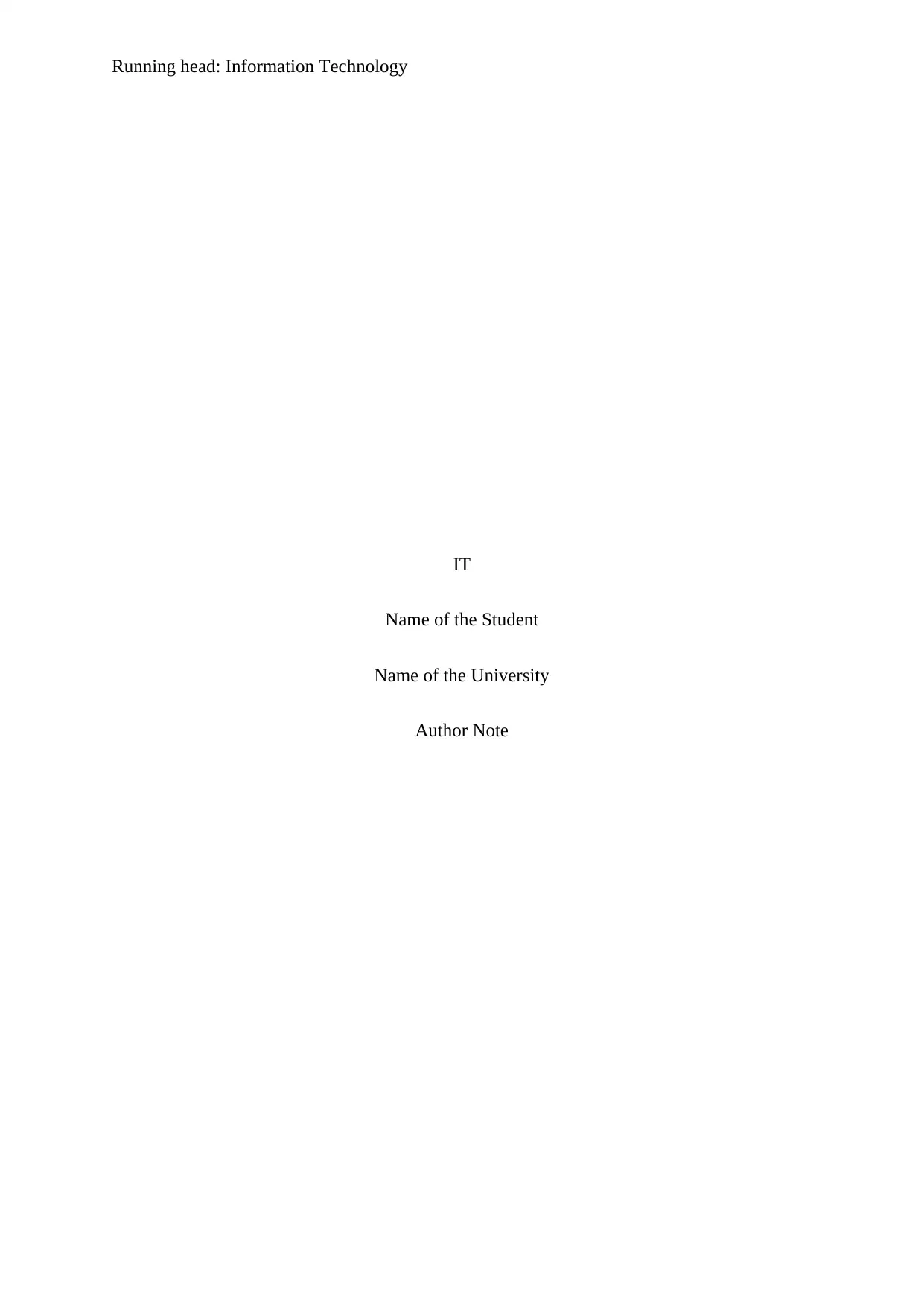
Running head: Information Technology
IT
Name of the Student
Name of the University
Author Note
IT
Name of the Student
Name of the University
Author Note
Paraphrase This Document
Need a fresh take? Get an instant paraphrase of this document with our AI Paraphraser
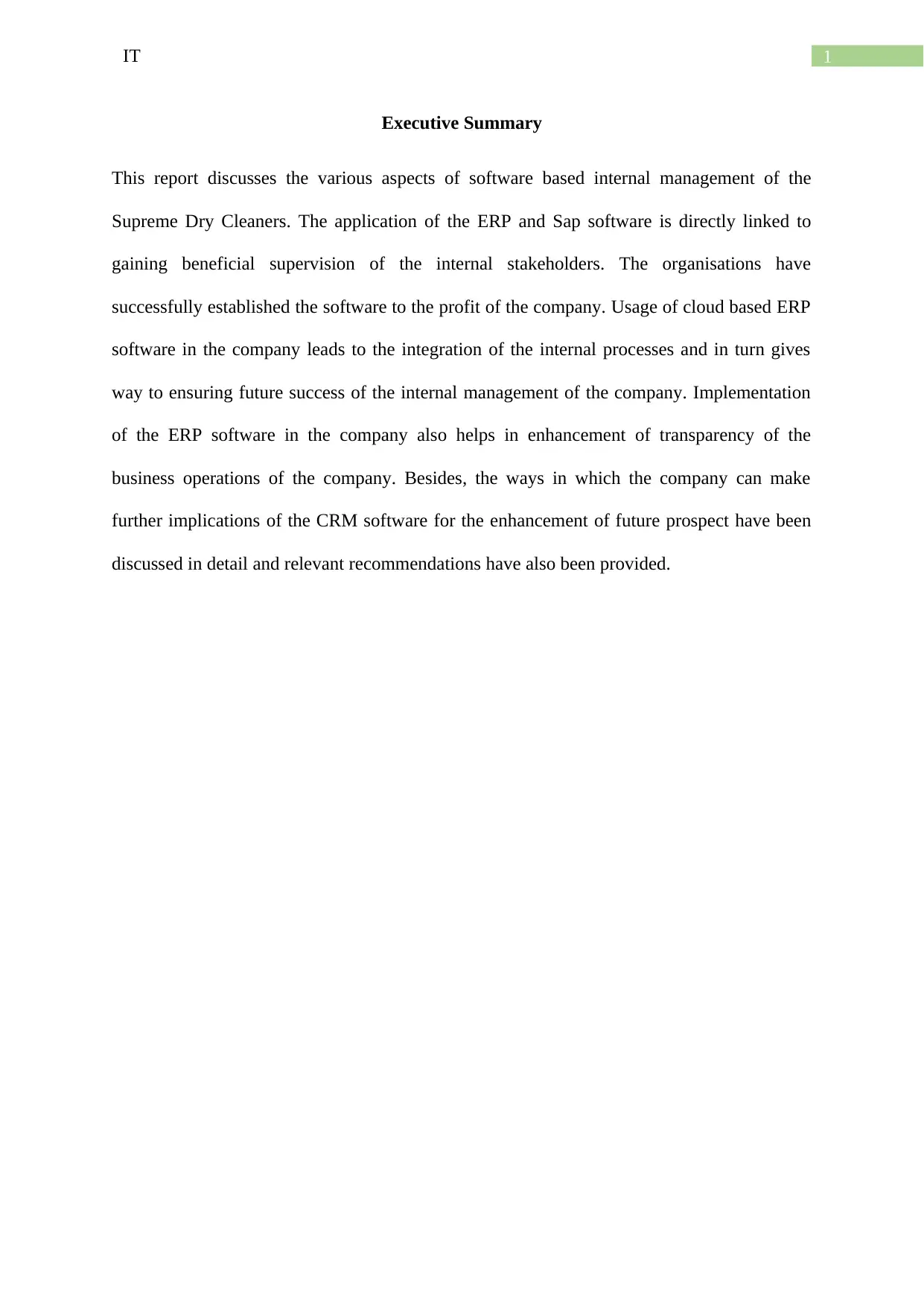
1IT
Executive Summary
This report discusses the various aspects of software based internal management of the
Supreme Dry Cleaners. The application of the ERP and Sap software is directly linked to
gaining beneficial supervision of the internal stakeholders. The organisations have
successfully established the software to the profit of the company. Usage of cloud based ERP
software in the company leads to the integration of the internal processes and in turn gives
way to ensuring future success of the internal management of the company. Implementation
of the ERP software in the company also helps in enhancement of transparency of the
business operations of the company. Besides, the ways in which the company can make
further implications of the CRM software for the enhancement of future prospect have been
discussed in detail and relevant recommendations have also been provided.
Executive Summary
This report discusses the various aspects of software based internal management of the
Supreme Dry Cleaners. The application of the ERP and Sap software is directly linked to
gaining beneficial supervision of the internal stakeholders. The organisations have
successfully established the software to the profit of the company. Usage of cloud based ERP
software in the company leads to the integration of the internal processes and in turn gives
way to ensuring future success of the internal management of the company. Implementation
of the ERP software in the company also helps in enhancement of transparency of the
business operations of the company. Besides, the ways in which the company can make
further implications of the CRM software for the enhancement of future prospect have been
discussed in detail and relevant recommendations have also been provided.
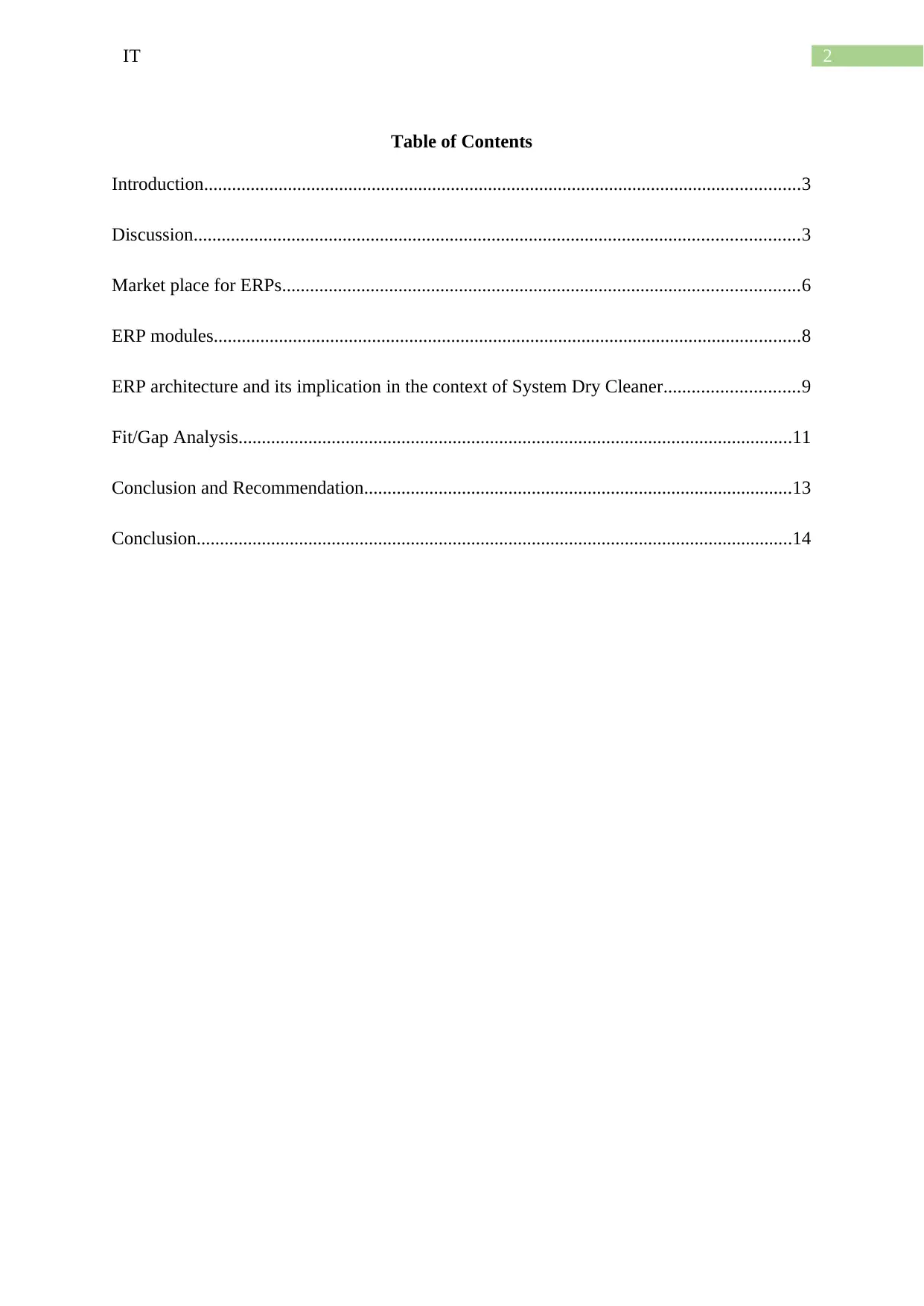
2IT
Table of Contents
Introduction................................................................................................................................3
Discussion..................................................................................................................................3
Market place for ERPs...............................................................................................................6
ERP modules..............................................................................................................................8
ERP architecture and its implication in the context of System Dry Cleaner.............................9
Fit/Gap Analysis.......................................................................................................................11
Conclusion and Recommendation............................................................................................13
Conclusion................................................................................................................................14
Table of Contents
Introduction................................................................................................................................3
Discussion..................................................................................................................................3
Market place for ERPs...............................................................................................................6
ERP modules..............................................................................................................................8
ERP architecture and its implication in the context of System Dry Cleaner.............................9
Fit/Gap Analysis.......................................................................................................................11
Conclusion and Recommendation............................................................................................13
Conclusion................................................................................................................................14
⊘ This is a preview!⊘
Do you want full access?
Subscribe today to unlock all pages.

Trusted by 1+ million students worldwide
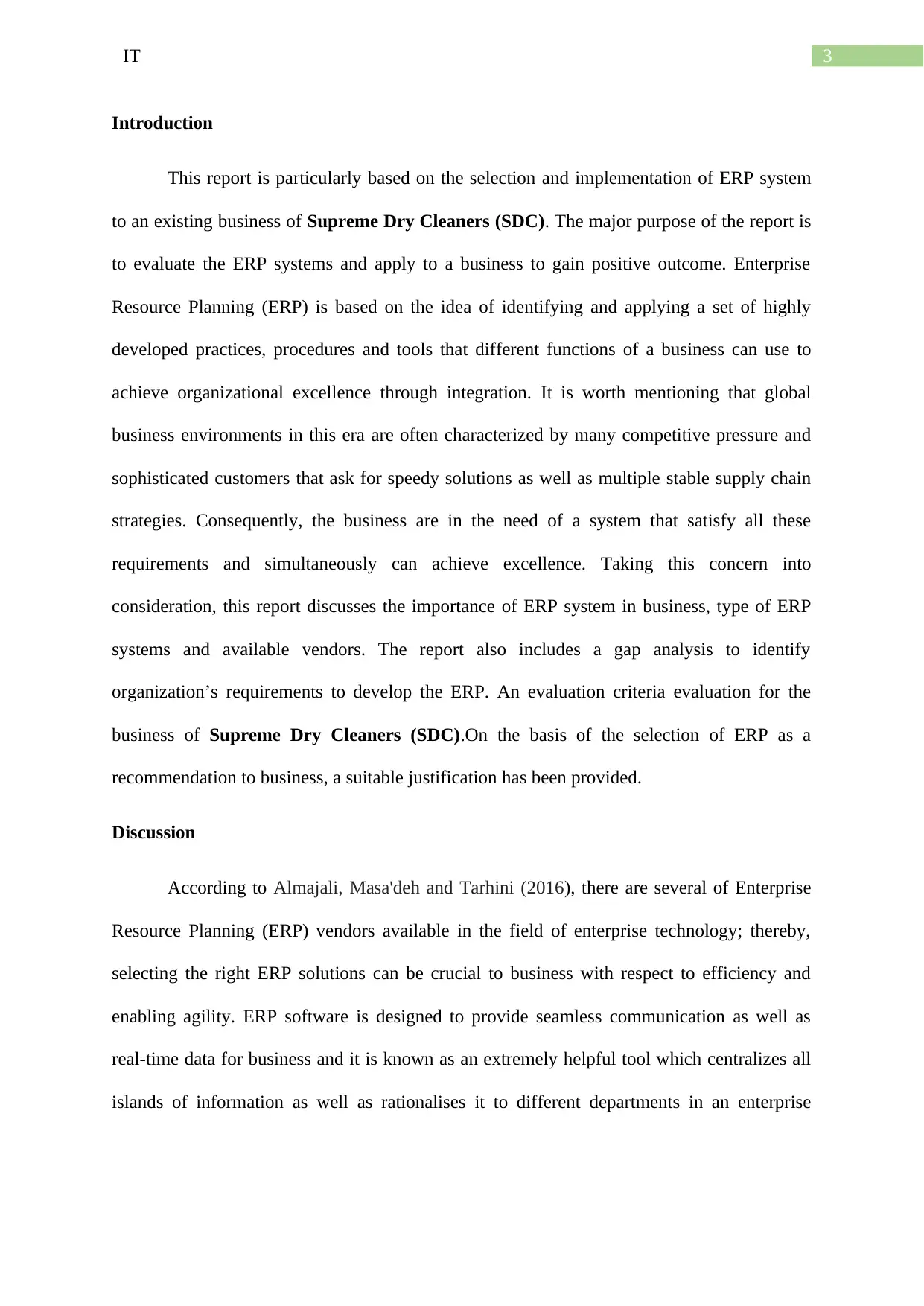
3IT
Introduction
This report is particularly based on the selection and implementation of ERP system
to an existing business of Supreme Dry Cleaners (SDC). The major purpose of the report is
to evaluate the ERP systems and apply to a business to gain positive outcome. Enterprise
Resource Planning (ERP) is based on the idea of identifying and applying a set of highly
developed practices, procedures and tools that different functions of a business can use to
achieve organizational excellence through integration. It is worth mentioning that global
business environments in this era are often characterized by many competitive pressure and
sophisticated customers that ask for speedy solutions as well as multiple stable supply chain
strategies. Consequently, the business are in the need of a system that satisfy all these
requirements and simultaneously can achieve excellence. Taking this concern into
consideration, this report discusses the importance of ERP system in business, type of ERP
systems and available vendors. The report also includes a gap analysis to identify
organization’s requirements to develop the ERP. An evaluation criteria evaluation for the
business of Supreme Dry Cleaners (SDC).On the basis of the selection of ERP as a
recommendation to business, a suitable justification has been provided.
Discussion
According to Almajali, Masa'deh and Tarhini (2016), there are several of Enterprise
Resource Planning (ERP) vendors available in the field of enterprise technology; thereby,
selecting the right ERP solutions can be crucial to business with respect to efficiency and
enabling agility. ERP software is designed to provide seamless communication as well as
real-time data for business and it is known as an extremely helpful tool which centralizes all
islands of information as well as rationalises it to different departments in an enterprise
Introduction
This report is particularly based on the selection and implementation of ERP system
to an existing business of Supreme Dry Cleaners (SDC). The major purpose of the report is
to evaluate the ERP systems and apply to a business to gain positive outcome. Enterprise
Resource Planning (ERP) is based on the idea of identifying and applying a set of highly
developed practices, procedures and tools that different functions of a business can use to
achieve organizational excellence through integration. It is worth mentioning that global
business environments in this era are often characterized by many competitive pressure and
sophisticated customers that ask for speedy solutions as well as multiple stable supply chain
strategies. Consequently, the business are in the need of a system that satisfy all these
requirements and simultaneously can achieve excellence. Taking this concern into
consideration, this report discusses the importance of ERP system in business, type of ERP
systems and available vendors. The report also includes a gap analysis to identify
organization’s requirements to develop the ERP. An evaluation criteria evaluation for the
business of Supreme Dry Cleaners (SDC).On the basis of the selection of ERP as a
recommendation to business, a suitable justification has been provided.
Discussion
According to Almajali, Masa'deh and Tarhini (2016), there are several of Enterprise
Resource Planning (ERP) vendors available in the field of enterprise technology; thereby,
selecting the right ERP solutions can be crucial to business with respect to efficiency and
enabling agility. ERP software is designed to provide seamless communication as well as
real-time data for business and it is known as an extremely helpful tool which centralizes all
islands of information as well as rationalises it to different departments in an enterprise
Paraphrase This Document
Need a fresh take? Get an instant paraphrase of this document with our AI Paraphraser
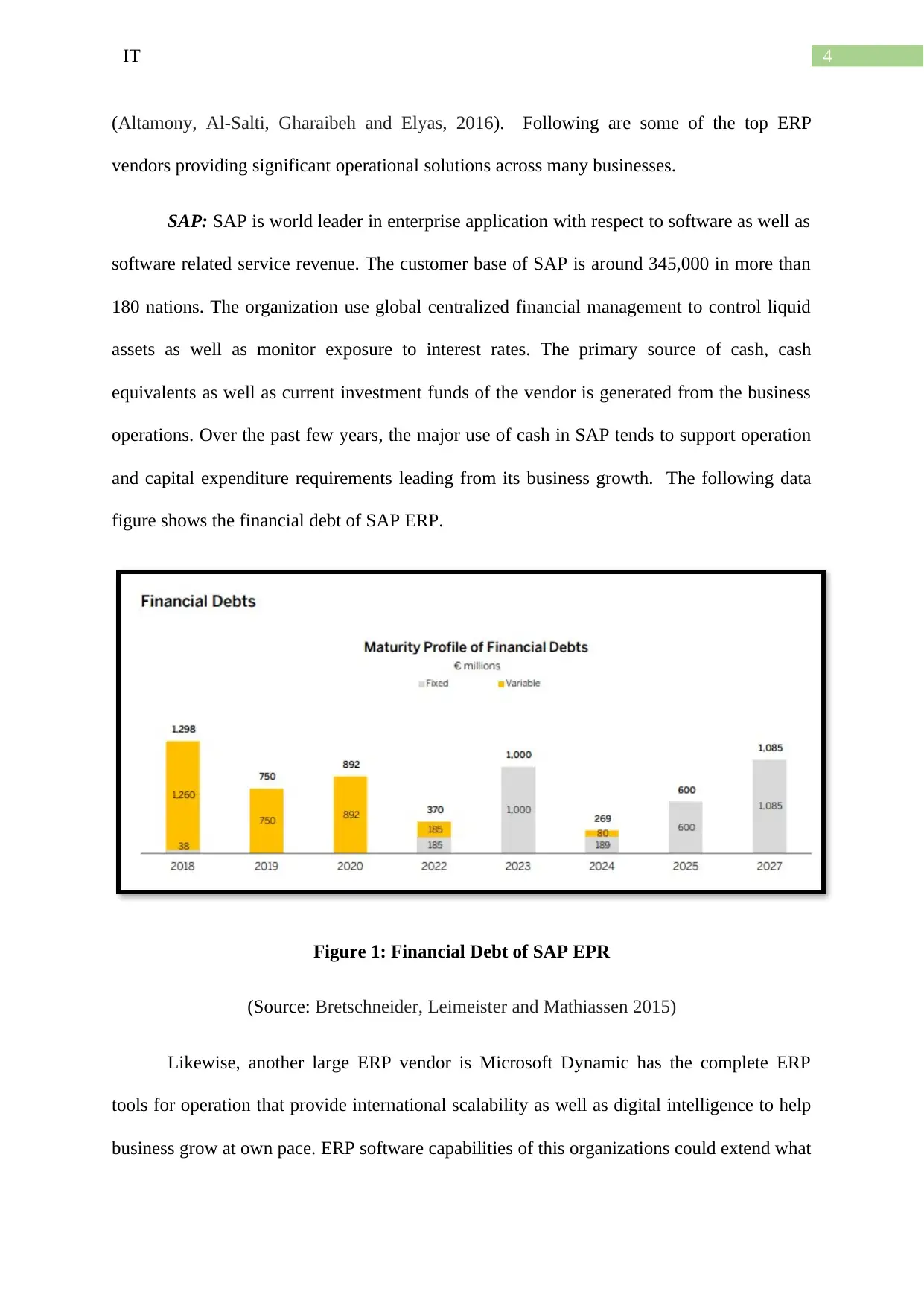
4IT
(Altamony, Al-Salti, Gharaibeh and Elyas, 2016). Following are some of the top ERP
vendors providing significant operational solutions across many businesses.
SAP: SAP is world leader in enterprise application with respect to software as well as
software related service revenue. The customer base of SAP is around 345,000 in more than
180 nations. The organization use global centralized financial management to control liquid
assets as well as monitor exposure to interest rates. The primary source of cash, cash
equivalents as well as current investment funds of the vendor is generated from the business
operations. Over the past few years, the major use of cash in SAP tends to support operation
and capital expenditure requirements leading from its business growth. The following data
figure shows the financial debt of SAP ERP.
Figure 1: Financial Debt of SAP EPR
(Source: Bretschneider, Leimeister and Mathiassen 2015)
Likewise, another large ERP vendor is Microsoft Dynamic has the complete ERP
tools for operation that provide international scalability as well as digital intelligence to help
business grow at own pace. ERP software capabilities of this organizations could extend what
(Altamony, Al-Salti, Gharaibeh and Elyas, 2016). Following are some of the top ERP
vendors providing significant operational solutions across many businesses.
SAP: SAP is world leader in enterprise application with respect to software as well as
software related service revenue. The customer base of SAP is around 345,000 in more than
180 nations. The organization use global centralized financial management to control liquid
assets as well as monitor exposure to interest rates. The primary source of cash, cash
equivalents as well as current investment funds of the vendor is generated from the business
operations. Over the past few years, the major use of cash in SAP tends to support operation
and capital expenditure requirements leading from its business growth. The following data
figure shows the financial debt of SAP ERP.
Figure 1: Financial Debt of SAP EPR
(Source: Bretschneider, Leimeister and Mathiassen 2015)
Likewise, another large ERP vendor is Microsoft Dynamic has the complete ERP
tools for operation that provide international scalability as well as digital intelligence to help
business grow at own pace. ERP software capabilities of this organizations could extend what
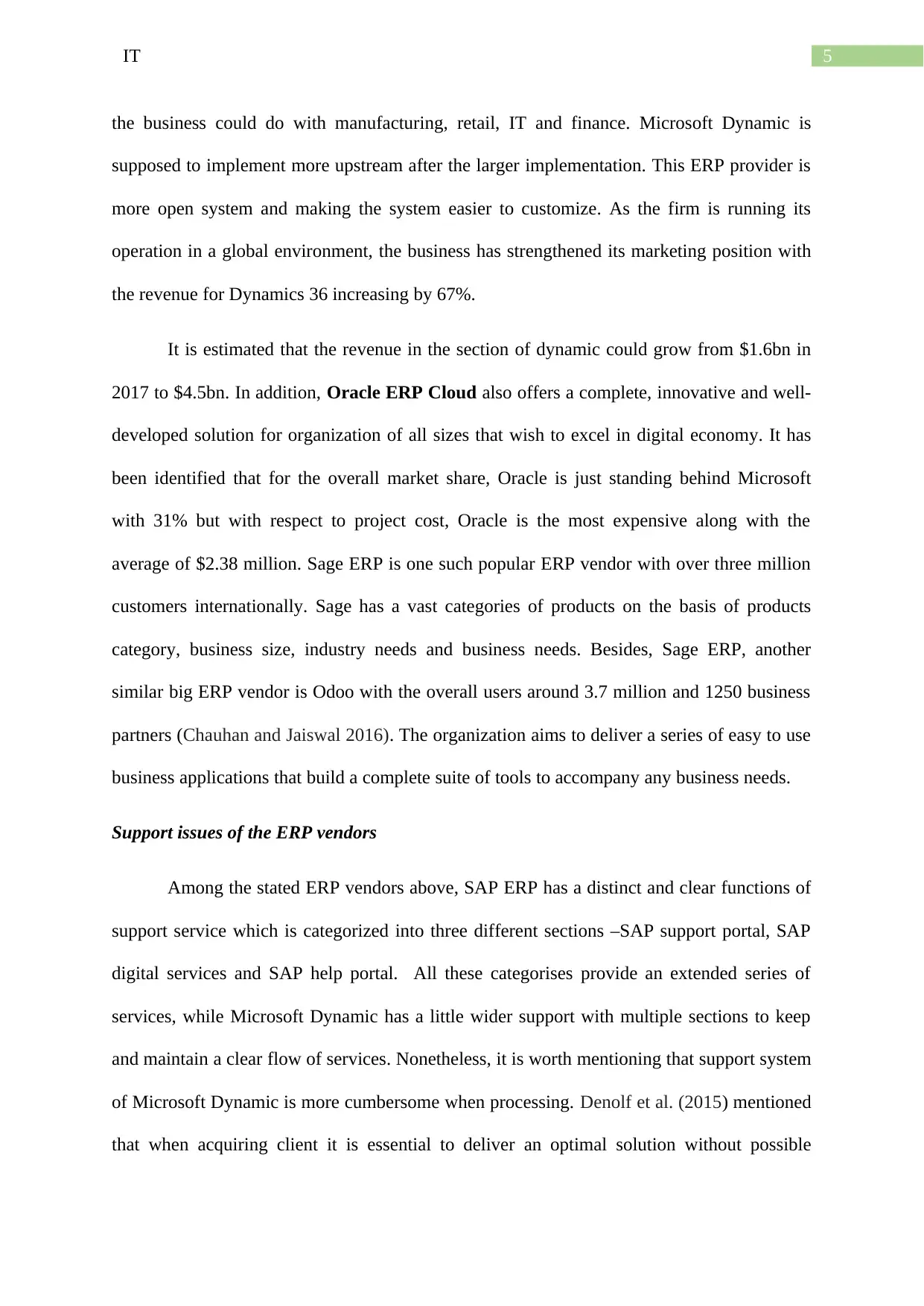
5IT
the business could do with manufacturing, retail, IT and finance. Microsoft Dynamic is
supposed to implement more upstream after the larger implementation. This ERP provider is
more open system and making the system easier to customize. As the firm is running its
operation in a global environment, the business has strengthened its marketing position with
the revenue for Dynamics 36 increasing by 67%.
It is estimated that the revenue in the section of dynamic could grow from $1.6bn in
2017 to $4.5bn. In addition, Oracle ERP Cloud also offers a complete, innovative and well-
developed solution for organization of all sizes that wish to excel in digital economy. It has
been identified that for the overall market share, Oracle is just standing behind Microsoft
with 31% but with respect to project cost, Oracle is the most expensive along with the
average of $2.38 million. Sage ERP is one such popular ERP vendor with over three million
customers internationally. Sage has a vast categories of products on the basis of products
category, business size, industry needs and business needs. Besides, Sage ERP, another
similar big ERP vendor is Odoo with the overall users around 3.7 million and 1250 business
partners (Chauhan and Jaiswal 2016). The organization aims to deliver a series of easy to use
business applications that build a complete suite of tools to accompany any business needs.
Support issues of the ERP vendors
Among the stated ERP vendors above, SAP ERP has a distinct and clear functions of
support service which is categorized into three different sections –SAP support portal, SAP
digital services and SAP help portal. All these categorises provide an extended series of
services, while Microsoft Dynamic has a little wider support with multiple sections to keep
and maintain a clear flow of services. Nonetheless, it is worth mentioning that support system
of Microsoft Dynamic is more cumbersome when processing. Denolf et al. (2015) mentioned
that when acquiring client it is essential to deliver an optimal solution without possible
the business could do with manufacturing, retail, IT and finance. Microsoft Dynamic is
supposed to implement more upstream after the larger implementation. This ERP provider is
more open system and making the system easier to customize. As the firm is running its
operation in a global environment, the business has strengthened its marketing position with
the revenue for Dynamics 36 increasing by 67%.
It is estimated that the revenue in the section of dynamic could grow from $1.6bn in
2017 to $4.5bn. In addition, Oracle ERP Cloud also offers a complete, innovative and well-
developed solution for organization of all sizes that wish to excel in digital economy. It has
been identified that for the overall market share, Oracle is just standing behind Microsoft
with 31% but with respect to project cost, Oracle is the most expensive along with the
average of $2.38 million. Sage ERP is one such popular ERP vendor with over three million
customers internationally. Sage has a vast categories of products on the basis of products
category, business size, industry needs and business needs. Besides, Sage ERP, another
similar big ERP vendor is Odoo with the overall users around 3.7 million and 1250 business
partners (Chauhan and Jaiswal 2016). The organization aims to deliver a series of easy to use
business applications that build a complete suite of tools to accompany any business needs.
Support issues of the ERP vendors
Among the stated ERP vendors above, SAP ERP has a distinct and clear functions of
support service which is categorized into three different sections –SAP support portal, SAP
digital services and SAP help portal. All these categorises provide an extended series of
services, while Microsoft Dynamic has a little wider support with multiple sections to keep
and maintain a clear flow of services. Nonetheless, it is worth mentioning that support system
of Microsoft Dynamic is more cumbersome when processing. Denolf et al. (2015) mentioned
that when acquiring client it is essential to deliver an optimal solution without possible
⊘ This is a preview!⊘
Do you want full access?
Subscribe today to unlock all pages.

Trusted by 1+ million students worldwide
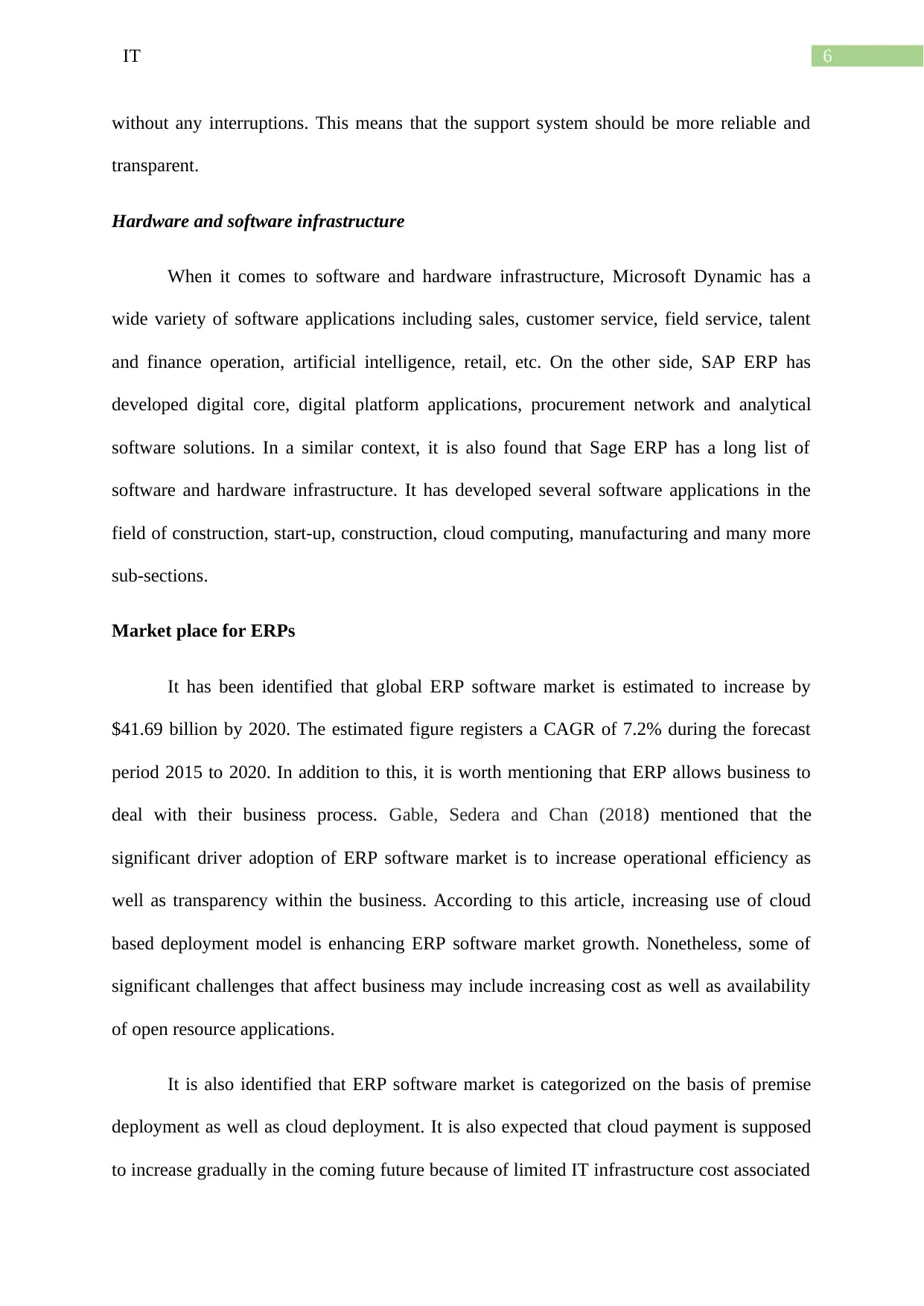
6IT
without any interruptions. This means that the support system should be more reliable and
transparent.
Hardware and software infrastructure
When it comes to software and hardware infrastructure, Microsoft Dynamic has a
wide variety of software applications including sales, customer service, field service, talent
and finance operation, artificial intelligence, retail, etc. On the other side, SAP ERP has
developed digital core, digital platform applications, procurement network and analytical
software solutions. In a similar context, it is also found that Sage ERP has a long list of
software and hardware infrastructure. It has developed several software applications in the
field of construction, start-up, construction, cloud computing, manufacturing and many more
sub-sections.
Market place for ERPs
It has been identified that global ERP software market is estimated to increase by
$41.69 billion by 2020. The estimated figure registers a CAGR of 7.2% during the forecast
period 2015 to 2020. In addition to this, it is worth mentioning that ERP allows business to
deal with their business process. Gable, Sedera and Chan (2018) mentioned that the
significant driver adoption of ERP software market is to increase operational efficiency as
well as transparency within the business. According to this article, increasing use of cloud
based deployment model is enhancing ERP software market growth. Nonetheless, some of
significant challenges that affect business may include increasing cost as well as availability
of open resource applications.
It is also identified that ERP software market is categorized on the basis of premise
deployment as well as cloud deployment. It is also expected that cloud payment is supposed
to increase gradually in the coming future because of limited IT infrastructure cost associated
without any interruptions. This means that the support system should be more reliable and
transparent.
Hardware and software infrastructure
When it comes to software and hardware infrastructure, Microsoft Dynamic has a
wide variety of software applications including sales, customer service, field service, talent
and finance operation, artificial intelligence, retail, etc. On the other side, SAP ERP has
developed digital core, digital platform applications, procurement network and analytical
software solutions. In a similar context, it is also found that Sage ERP has a long list of
software and hardware infrastructure. It has developed several software applications in the
field of construction, start-up, construction, cloud computing, manufacturing and many more
sub-sections.
Market place for ERPs
It has been identified that global ERP software market is estimated to increase by
$41.69 billion by 2020. The estimated figure registers a CAGR of 7.2% during the forecast
period 2015 to 2020. In addition to this, it is worth mentioning that ERP allows business to
deal with their business process. Gable, Sedera and Chan (2018) mentioned that the
significant driver adoption of ERP software market is to increase operational efficiency as
well as transparency within the business. According to this article, increasing use of cloud
based deployment model is enhancing ERP software market growth. Nonetheless, some of
significant challenges that affect business may include increasing cost as well as availability
of open resource applications.
It is also identified that ERP software market is categorized on the basis of premise
deployment as well as cloud deployment. It is also expected that cloud payment is supposed
to increase gradually in the coming future because of limited IT infrastructure cost associated
Paraphrase This Document
Need a fresh take? Get an instant paraphrase of this document with our AI Paraphraser
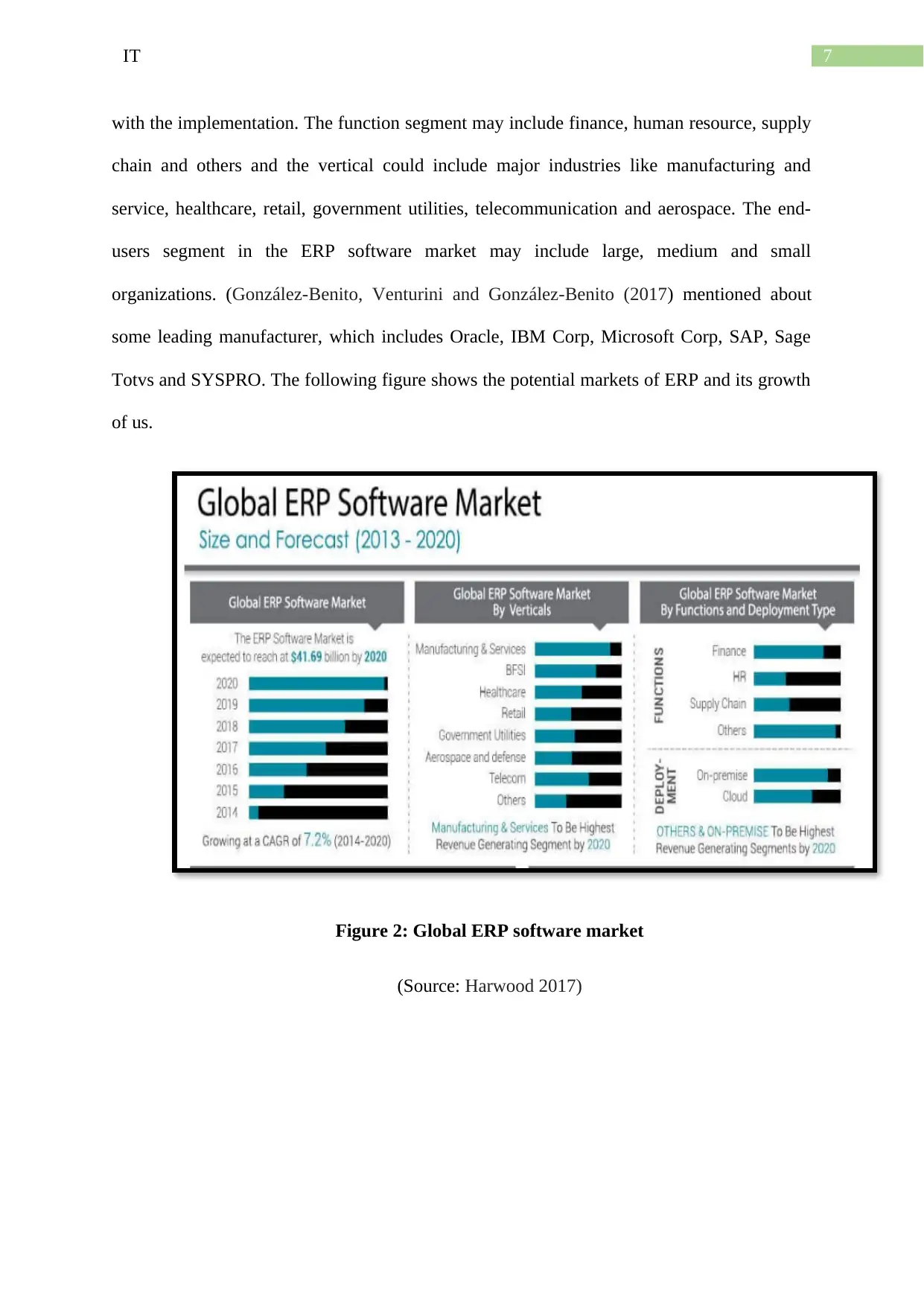
7IT
with the implementation. The function segment may include finance, human resource, supply
chain and others and the vertical could include major industries like manufacturing and
service, healthcare, retail, government utilities, telecommunication and aerospace. The end-
users segment in the ERP software market may include large, medium and small
organizations. (González-Benito, Venturini and González-Benito (2017) mentioned about
some leading manufacturer, which includes Oracle, IBM Corp, Microsoft Corp, SAP, Sage
Totvs and SYSPRO. The following figure shows the potential markets of ERP and its growth
of us.
Figure 2: Global ERP software market
(Source: Harwood 2017)
with the implementation. The function segment may include finance, human resource, supply
chain and others and the vertical could include major industries like manufacturing and
service, healthcare, retail, government utilities, telecommunication and aerospace. The end-
users segment in the ERP software market may include large, medium and small
organizations. (González-Benito, Venturini and González-Benito (2017) mentioned about
some leading manufacturer, which includes Oracle, IBM Corp, Microsoft Corp, SAP, Sage
Totvs and SYSPRO. The following figure shows the potential markets of ERP and its growth
of us.
Figure 2: Global ERP software market
(Source: Harwood 2017)
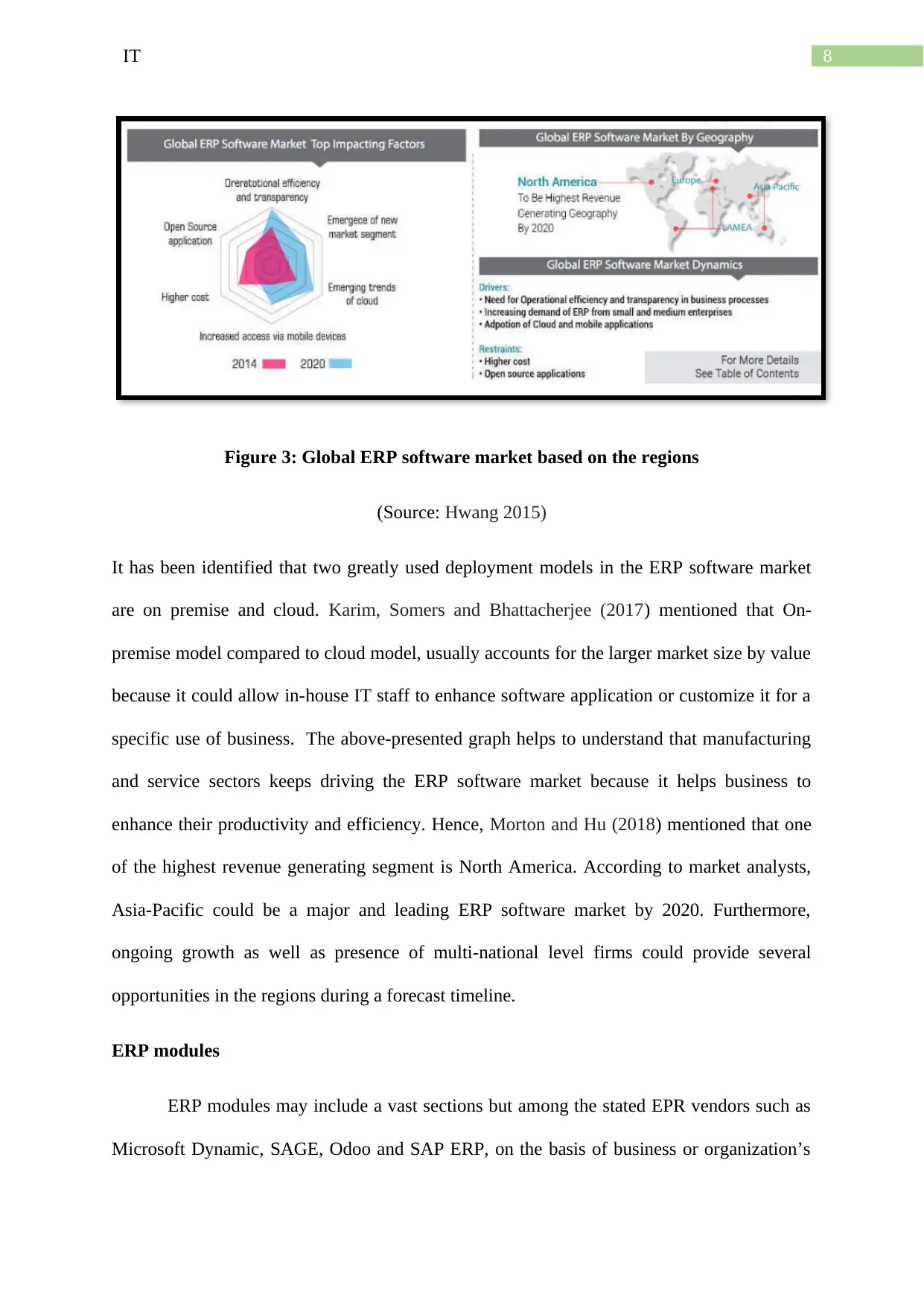
8IT
Figure 3: Global ERP software market based on the regions
(Source: Hwang 2015)
It has been identified that two greatly used deployment models in the ERP software market
are on premise and cloud. Karim, Somers and Bhattacherjee (2017) mentioned that On-
premise model compared to cloud model, usually accounts for the larger market size by value
because it could allow in-house IT staff to enhance software application or customize it for a
specific use of business. The above-presented graph helps to understand that manufacturing
and service sectors keeps driving the ERP software market because it helps business to
enhance their productivity and efficiency. Hence, Morton and Hu (2018) mentioned that one
of the highest revenue generating segment is North America. According to market analysts,
Asia-Pacific could be a major and leading ERP software market by 2020. Furthermore,
ongoing growth as well as presence of multi-national level firms could provide several
opportunities in the regions during a forecast timeline.
ERP modules
ERP modules may include a vast sections but among the stated EPR vendors such as
Microsoft Dynamic, SAGE, Odoo and SAP ERP, on the basis of business or organization’s
Figure 3: Global ERP software market based on the regions
(Source: Hwang 2015)
It has been identified that two greatly used deployment models in the ERP software market
are on premise and cloud. Karim, Somers and Bhattacherjee (2017) mentioned that On-
premise model compared to cloud model, usually accounts for the larger market size by value
because it could allow in-house IT staff to enhance software application or customize it for a
specific use of business. The above-presented graph helps to understand that manufacturing
and service sectors keeps driving the ERP software market because it helps business to
enhance their productivity and efficiency. Hence, Morton and Hu (2018) mentioned that one
of the highest revenue generating segment is North America. According to market analysts,
Asia-Pacific could be a major and leading ERP software market by 2020. Furthermore,
ongoing growth as well as presence of multi-national level firms could provide several
opportunities in the regions during a forecast timeline.
ERP modules
ERP modules may include a vast sections but among the stated EPR vendors such as
Microsoft Dynamic, SAGE, Odoo and SAP ERP, on the basis of business or organization’s
⊘ This is a preview!⊘
Do you want full access?
Subscribe today to unlock all pages.

Trusted by 1+ million students worldwide
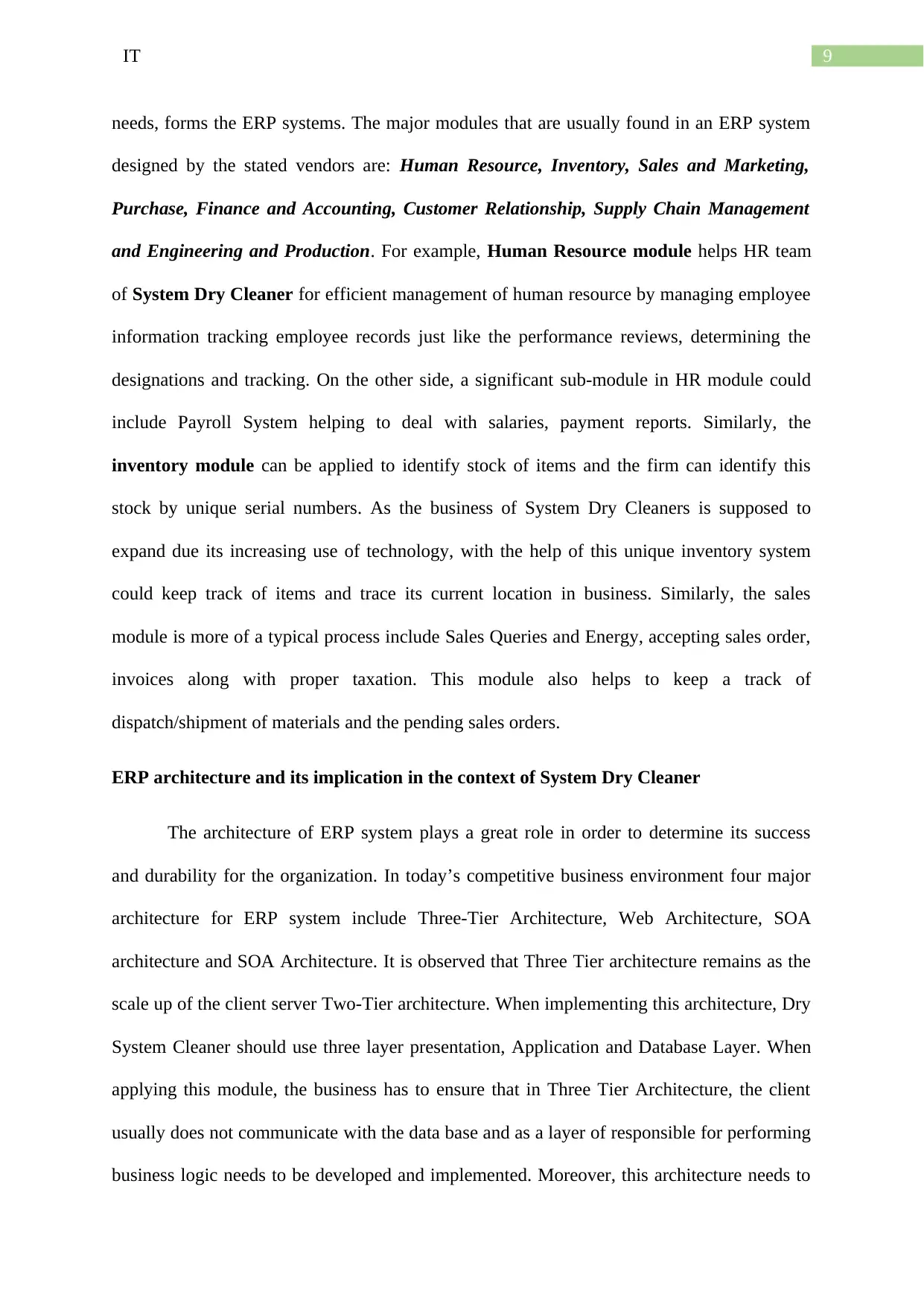
9IT
needs, forms the ERP systems. The major modules that are usually found in an ERP system
designed by the stated vendors are: Human Resource, Inventory, Sales and Marketing,
Purchase, Finance and Accounting, Customer Relationship, Supply Chain Management
and Engineering and Production. For example, Human Resource module helps HR team
of System Dry Cleaner for efficient management of human resource by managing employee
information tracking employee records just like the performance reviews, determining the
designations and tracking. On the other side, a significant sub-module in HR module could
include Payroll System helping to deal with salaries, payment reports. Similarly, the
inventory module can be applied to identify stock of items and the firm can identify this
stock by unique serial numbers. As the business of System Dry Cleaners is supposed to
expand due its increasing use of technology, with the help of this unique inventory system
could keep track of items and trace its current location in business. Similarly, the sales
module is more of a typical process include Sales Queries and Energy, accepting sales order,
invoices along with proper taxation. This module also helps to keep a track of
dispatch/shipment of materials and the pending sales orders.
ERP architecture and its implication in the context of System Dry Cleaner
The architecture of ERP system plays a great role in order to determine its success
and durability for the organization. In today’s competitive business environment four major
architecture for ERP system include Three-Tier Architecture, Web Architecture, SOA
architecture and SOA Architecture. It is observed that Three Tier architecture remains as the
scale up of the client server Two-Tier architecture. When implementing this architecture, Dry
System Cleaner should use three layer presentation, Application and Database Layer. When
applying this module, the business has to ensure that in Three Tier Architecture, the client
usually does not communicate with the data base and as a layer of responsible for performing
business logic needs to be developed and implemented. Moreover, this architecture needs to
needs, forms the ERP systems. The major modules that are usually found in an ERP system
designed by the stated vendors are: Human Resource, Inventory, Sales and Marketing,
Purchase, Finance and Accounting, Customer Relationship, Supply Chain Management
and Engineering and Production. For example, Human Resource module helps HR team
of System Dry Cleaner for efficient management of human resource by managing employee
information tracking employee records just like the performance reviews, determining the
designations and tracking. On the other side, a significant sub-module in HR module could
include Payroll System helping to deal with salaries, payment reports. Similarly, the
inventory module can be applied to identify stock of items and the firm can identify this
stock by unique serial numbers. As the business of System Dry Cleaners is supposed to
expand due its increasing use of technology, with the help of this unique inventory system
could keep track of items and trace its current location in business. Similarly, the sales
module is more of a typical process include Sales Queries and Energy, accepting sales order,
invoices along with proper taxation. This module also helps to keep a track of
dispatch/shipment of materials and the pending sales orders.
ERP architecture and its implication in the context of System Dry Cleaner
The architecture of ERP system plays a great role in order to determine its success
and durability for the organization. In today’s competitive business environment four major
architecture for ERP system include Three-Tier Architecture, Web Architecture, SOA
architecture and SOA Architecture. It is observed that Three Tier architecture remains as the
scale up of the client server Two-Tier architecture. When implementing this architecture, Dry
System Cleaner should use three layer presentation, Application and Database Layer. When
applying this module, the business has to ensure that in Three Tier Architecture, the client
usually does not communicate with the data base and as a layer of responsible for performing
business logic needs to be developed and implemented. Moreover, this architecture needs to
Paraphrase This Document
Need a fresh take? Get an instant paraphrase of this document with our AI Paraphraser
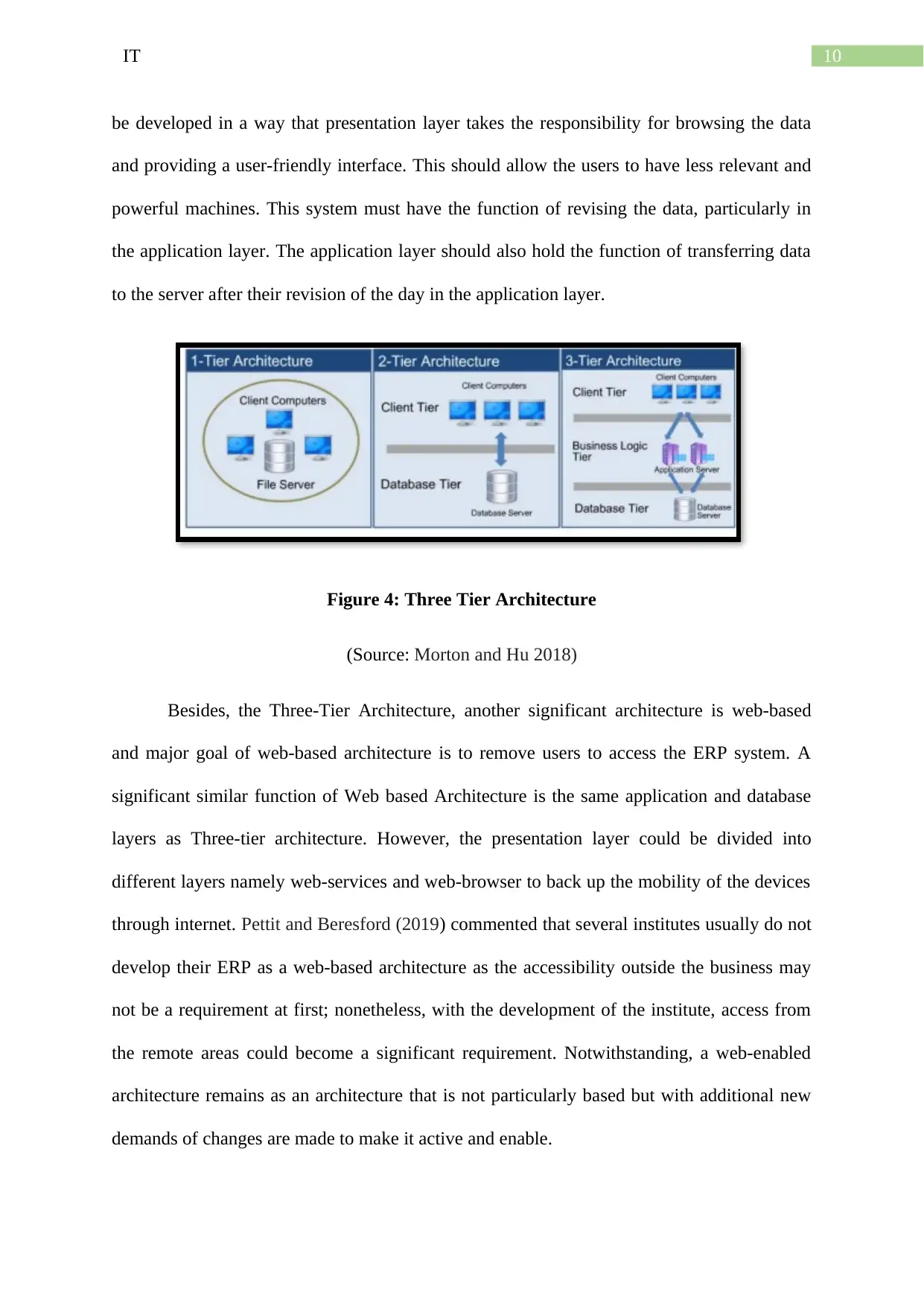
10IT
be developed in a way that presentation layer takes the responsibility for browsing the data
and providing a user-friendly interface. This should allow the users to have less relevant and
powerful machines. This system must have the function of revising the data, particularly in
the application layer. The application layer should also hold the function of transferring data
to the server after their revision of the day in the application layer.
Figure 4: Three Tier Architecture
(Source: Morton and Hu 2018)
Besides, the Three-Tier Architecture, another significant architecture is web-based
and major goal of web-based architecture is to remove users to access the ERP system. A
significant similar function of Web based Architecture is the same application and database
layers as Three-tier architecture. However, the presentation layer could be divided into
different layers namely web-services and web-browser to back up the mobility of the devices
through internet. Pettit and Beresford (2019) commented that several institutes usually do not
develop their ERP as a web-based architecture as the accessibility outside the business may
not be a requirement at first; nonetheless, with the development of the institute, access from
the remote areas could become a significant requirement. Notwithstanding, a web-enabled
architecture remains as an architecture that is not particularly based but with additional new
demands of changes are made to make it active and enable.
be developed in a way that presentation layer takes the responsibility for browsing the data
and providing a user-friendly interface. This should allow the users to have less relevant and
powerful machines. This system must have the function of revising the data, particularly in
the application layer. The application layer should also hold the function of transferring data
to the server after their revision of the day in the application layer.
Figure 4: Three Tier Architecture
(Source: Morton and Hu 2018)
Besides, the Three-Tier Architecture, another significant architecture is web-based
and major goal of web-based architecture is to remove users to access the ERP system. A
significant similar function of Web based Architecture is the same application and database
layers as Three-tier architecture. However, the presentation layer could be divided into
different layers namely web-services and web-browser to back up the mobility of the devices
through internet. Pettit and Beresford (2019) commented that several institutes usually do not
develop their ERP as a web-based architecture as the accessibility outside the business may
not be a requirement at first; nonetheless, with the development of the institute, access from
the remote areas could become a significant requirement. Notwithstanding, a web-enabled
architecture remains as an architecture that is not particularly based but with additional new
demands of changes are made to make it active and enable.
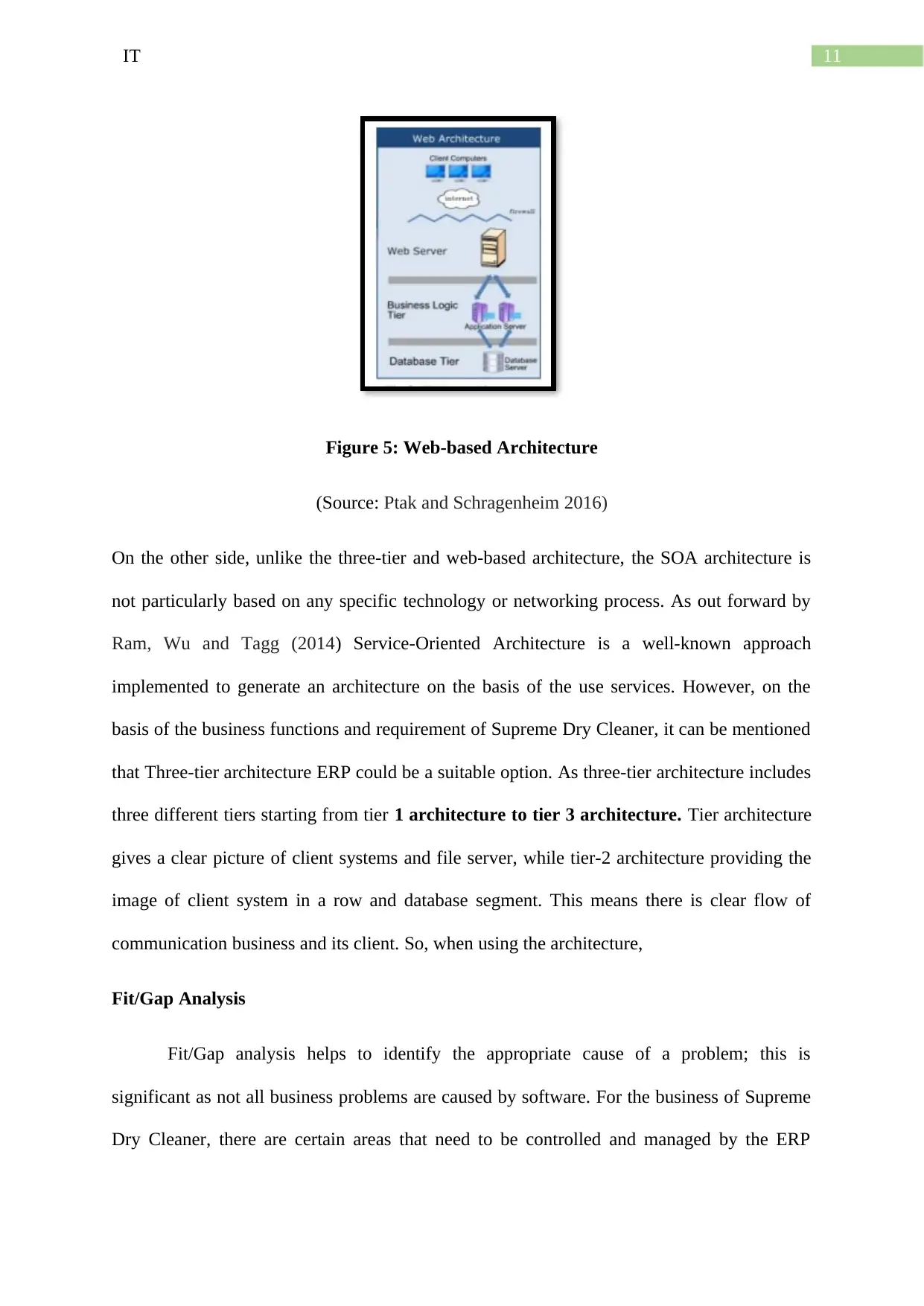
11IT
Figure 5: Web-based Architecture
(Source: Ptak and Schragenheim 2016)
On the other side, unlike the three-tier and web-based architecture, the SOA architecture is
not particularly based on any specific technology or networking process. As out forward by
Ram, Wu and Tagg (2014) Service-Oriented Architecture is a well-known approach
implemented to generate an architecture on the basis of the use services. However, on the
basis of the business functions and requirement of Supreme Dry Cleaner, it can be mentioned
that Three-tier architecture ERP could be a suitable option. As three-tier architecture includes
three different tiers starting from tier 1 architecture to tier 3 architecture. Tier architecture
gives a clear picture of client systems and file server, while tier-2 architecture providing the
image of client system in a row and database segment. This means there is clear flow of
communication business and its client. So, when using the architecture,
Fit/Gap Analysis
Fit/Gap analysis helps to identify the appropriate cause of a problem; this is
significant as not all business problems are caused by software. For the business of Supreme
Dry Cleaner, there are certain areas that need to be controlled and managed by the ERP
Figure 5: Web-based Architecture
(Source: Ptak and Schragenheim 2016)
On the other side, unlike the three-tier and web-based architecture, the SOA architecture is
not particularly based on any specific technology or networking process. As out forward by
Ram, Wu and Tagg (2014) Service-Oriented Architecture is a well-known approach
implemented to generate an architecture on the basis of the use services. However, on the
basis of the business functions and requirement of Supreme Dry Cleaner, it can be mentioned
that Three-tier architecture ERP could be a suitable option. As three-tier architecture includes
three different tiers starting from tier 1 architecture to tier 3 architecture. Tier architecture
gives a clear picture of client systems and file server, while tier-2 architecture providing the
image of client system in a row and database segment. This means there is clear flow of
communication business and its client. So, when using the architecture,
Fit/Gap Analysis
Fit/Gap analysis helps to identify the appropriate cause of a problem; this is
significant as not all business problems are caused by software. For the business of Supreme
Dry Cleaner, there are certain areas that need to be controlled and managed by the ERP
⊘ This is a preview!⊘
Do you want full access?
Subscribe today to unlock all pages.

Trusted by 1+ million students worldwide
1 out of 18
Related Documents
Your All-in-One AI-Powered Toolkit for Academic Success.
+13062052269
info@desklib.com
Available 24*7 on WhatsApp / Email
![[object Object]](/_next/static/media/star-bottom.7253800d.svg)
Unlock your academic potential
Copyright © 2020–2025 A2Z Services. All Rights Reserved. Developed and managed by ZUCOL.





